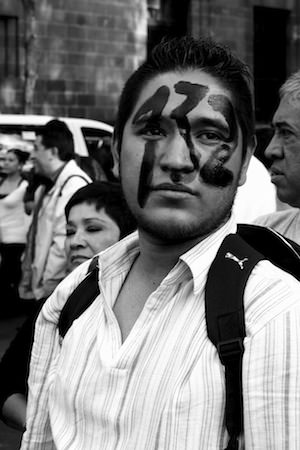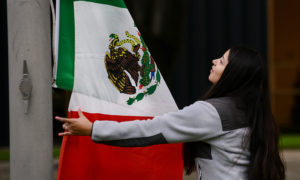Mexico’s Yo Soy 132 Sings Its Own Songs
With a boost from Twitter, music may re-emerge as a tool for raising political consciousness among the nation's young.Music has added an important voice of opposition leading up to Sunday's presidential election. But will its influence last?
A day before the second large march of the Yo Soy 132 student movement in Mexico City in May, the journalist Carmen Aristegui asked her audience to help create “the soundtrack for the marches.” Using the Twitter hashtag #CancionesParaMarchar (songs for marching), more than 10,000 people weighed in with political playlists. While there was plenty of support for international acts like Pink Floyd (“Another Brick in the Wall”) and Mercedes Sosa (“Sólo le Pido a Dios”), most of the votes went to homegrown favorites who know the inner workings of Mexican politics and social inequality all too well.
Ska populists Panteon Rococo were high on the list with their frenetic horn blast from 2002, “La Carencia” (they shout: “the poor have no place!”), as were alt-rock icons Caifanes, whose evergreen 1990 anthem “Antes de que nos olviden” (Before we’re forgotten) memorialized the 1968 massacre of student protesters by pledging “we will make history.” Yet the overwhelming song favorite (with 57 percent of the votes) was “Gimme the Power,” the sneering middle-finger singalong recorded by the Mexico City band Molotov in 1997. “We’ve got to cut the problem out at the root, and change the government of our country,” they sang during that final decade of 70 years of rule by the right-wing party PRI.
On the one hand, the picks shouldn’t have been much of a surprise. Critiquing institutionalized poverty, fighting historical amnesia and bellowing regime change are all aims that resonate loudly with Yo Soy 132. Ever since an unexpected demonstration by private school students at the Ibero-American University forced PRI candidate Enrique Peña Nieto to take shelter in a campus restroom May 11, the movement has galvanized nationwide youth-driven opposition not only to the feared return of the anti-democratic PRI, but to chronic political corruption, media monopolization and electoral fraud. (The movement’s name, “I am 132,” stems from a declaration of allegiance to the first 131 students who put their faces on the movement.)
The movement’s rapid upsurge and viral spread — across social networks, across universities private and public — form a 21st century chapter of the ceaseless revolutionary cycle that John Gilber has called “Mexico unconquered,” an unappeasable “social hunger” for justice and equality that runs throughout the course of Mexican history, from the Zapatistas to Oaxacan teachers’ strikes to Yo Soy 132 forcing a nonofficial, presidential campaign debate on June 19 (among all the candidates except the missing-in-action Peña Nieto).
What was surprising about the #CancionesParaMarchar rankings, however, was that of the top 15 songs in Aristegui’s tweet roundup, not one was from the Yo Soy 132 generation itself. At first blush, the lack of a musical representative from Mexico’s millennials seemed to give credence to what Juan Pablo Proal, writing on the pages of Proceso in April, bemoaned as contemporary Mexican rock’s widespread political malaise. Proal looked for outrage and dissent and found nothing but escapism, indifference and apathy. Wielding a literal (and limiting) set of criteria, Proal argued that if lyrics don’t talk about the drug war or violence or unemployment, then the music is just a “reflection of a nation of fairy-tales.”
As flawed as his approach was, Proal’s larger beef still haunted the #CancionesParaMarchar results: Where was the music that would mobilize this generation that came of age under democracy, “free trade” and neoliberalism? If not overt protest tunes, then where were the love songs, folk odes and subterranean after-hours antro hits that would help teenagers and university students shape the social, creative and ethical consciousness of their generation? Or as Tijuana music critic Ejival mused in his own Twitter post: “I keep waiting for the musical revolution of the Mexican Spring. But no, I forgot that music is no longer the medium for new revolutions.”
Music has certainly not been the spark of the Yo Soy 132 movement, and certainly not its principal medium (that honor belongs most squarely to Twitter and Facebook themselves — this is a #movement after all). But as the British political scientist John Street points out in his new book “Music and Politics,” music’s political potential shouldn’t be limited to either sonic cause or measurable musical effect. “Music embodies political values and experiences,” he writes, “and organizes our response to society as political thought and action. Music does not just provide a vehicle of political expression, it is that expression.”Along with its online manifestos and massive offline street marches, the political expression of Yo Soy 132 has increasingly taken musical forms — explored, tested, articulated, mobilized and dreamed in songs, jam sessions and artist collectives that are as at home with picket signs as they are with streaming audio widgets. In large part, this is due to the creation of yet another hashtag action network, #MusicosYoSoy132, which invited participation from anyone interested in being “united by the rhythm of a just and free Mexico.” Musicians across Mexico quickly pledged allegiance, producing a barrage of solidarity posts on Twitter as well as a series of videos featuring well-known Mexican artists declaring their support.
The first video, which went live on YouTube at the beginning of this month, led off with a statement by popular singer-songwriter Natalia Lafourcade. “We are at a critical juncture in the history of Mexico,” she says, “and it has given birth to an unprecedented civic movement.” Lafourcade then took to Twitter to crowd-source lyrics for what would become “Un Derecho de Nacimiento,” a song dedicated to the dream of a “better Mexico” and anchored to a chorus that insists “I was not born without a cause.” She performed it at a #MusicosYoSoy132-sponsored concert held in the Zócalo, Mexico City’s biggest and most symbolic site of public gathering (be it for a march against Peña Nieto or a Justin Bieber concert). Also on the bill were favorites like Julieta Venegas, Vicente Gayo and Torreblanca, who with help from journalist and singer Pati Peñaloza made connections between Yo Soy 132 and the Chilean student movement by performing a version of Violeta Parra’s “Me gustan los estudiantes,” the 1960s classic that was revived in recent demonstrations in Chile.
Also appearing in the first #MusicosYoSoy132 video was electronic musician Camilo Lara, aka Mexican Institute of Sound, who days before had been to the Zócalo himself to film a video for his latest single, “Mexico.” In the video, Lara wears a Yo Soy 132 T-shirt and choreographs his own march alongside an actual one — a June 3 demonstration for the victims of an infamous, and still unprosecuted, 2009 day-care fire in Hermosillo that left 49 children dead. Singing alongside fellow protesters, he portrays the Mexican government as a drug cartel that rules with violence and impunity under the three colors of the Mexican flag: “green for the pot, white for the coke and red for the blood.” The song ends by rewriting the Mexican national anthem as a narcocorrido in which the patriotic “sonic roar of the cannon” is now the menacing soundtrack of a government “growing pot with its own hands.”
For a movement so critical of neoliberalism and corporate media, it’s heartening to see just how much Yo Soy 132 music has been made strictly for marching and organizing, not markets. In one demonstration against the PRI’s economic control of media giant Televisa, protesters created a wall of music that surrounded the company’s headquarters, and in another demonstration they held a fandango for justice and truth. There was also the staging of a mock Televisa funeral by a group of Yo Soy 132 artists who hired a mariachi to sing the wrenching cemetery staple “Las Golondrinas” (The Swallows) just outside the company’s gates. In the song, the swallows fly away and may never return, sad symbols of lost loves, lost friends and lost homelands.
There have also been two grass-roots attempts at creating unofficial movement anthems. The Colectivo Emergente de Artistas Independientes (Emerging Collective of Independent Artists) recorded the sprightly “#Cumbia 132,” which tries to make you dance to lyrics about democratic elections, government repression and refusing to be anybody’s sheep, and students from La Escuela Nacional de la Música (National School of Music) came up with “Himno 132 (Llegó el día).” Released on their blog musicosaliados.blogspot.com and soundcloud page alongside other student-made movement songs, march photos and YouTube videos, the song’s mix of jarocho, jazz and reggae calls for hope and action in a climate of ignorance and fear: “The day has arrived/ Let’s raise our voices/ We are students in rebellion/ We are 132.”
Yet with Sunday’s election looming, all of this musical mobilization faces the same question that’s staring down the Yo Soy 132 movement itself. No matter who wins on July 1, will the music and the movement continue to be heard once the fever of the campaign cools down? Like the swallows of “Las Golondrinas,” will they just fly away, or will they return and keep on singing?
Josh Kun is a professor at the USC Annenberg School for Communication & Journalism, where he directs the Popular Music Project of the Norman Lear Center.
Your support matters…Independent journalism is under threat and overshadowed by heavily funded mainstream media.
You can help level the playing field. Become a member.
Your tax-deductible contribution keeps us digging beneath the headlines to give you thought-provoking, investigative reporting and analysis that unearths what's really happening- without compromise.
Give today to support our courageous, independent journalists.




You need to be a supporter to comment.
There are currently no responses to this article.
Be the first to respond.